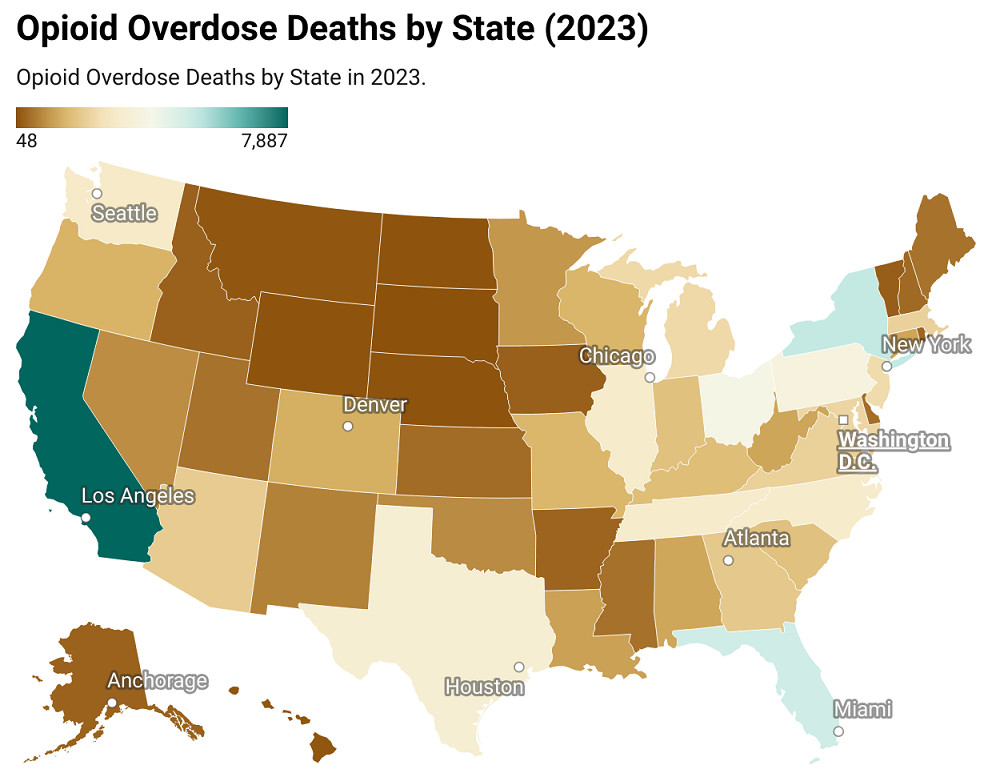Reviews
The Nation’s Opioid Crisis: New Findings Reveal Nearly 80,000 Lives Lost in a Single Year

A new report from White Law reveals that the opioid epidemic in the United States has reached devastating new heights. In 2023, an estimated 79,355 people died from opioid overdoses—an average of 217 deaths per day. This tragic figure highlights the ongoing destruction the crisis inflicts on families and communities across the country. The surge is largely driven by the widespread presence of synthetic opioids like fentanyl, a drug that is 50 to 100 times more powerful than morphine.
Despite greater public awareness and various legislative efforts over recent years, opioid addiction remains one of the nation’s most pressing public health emergencies. In 2023, pharmacies throughout the U.S. filled over 125 million opioid prescriptions, maintaining the easy accessibility of these dangerous substances. While some regulations have been implemented to restrict prescribing practices, the latest data suggests that more stringent measures are necessary to curb new addictions.
Currently, approximately 5.7 million Americans live with Opioid Use Disorder (OUD), a condition that, while treatable, remains difficult to overcome. Many individuals struggling with OUD encounter serious obstacles to recovery, including limited access to treatment programs, high costs, insurance barriers, and societal stigma. Without access to proven resources like medication-assisted treatment (MAT), counseling, and peer support groups, those seeking help are often left without effective pathways to recovery.
Who Is Most Affected?
The opioid epidemic affects people across all walks of life, yet certain demographics are disproportionately impacted:
- 71.6% of overdose deaths were male.
- 61.3% of those who died were white.
- 23% were Black.
- 11.7% were Hispanic.
- 1.8% were American Indian.
- 1.3% were multi-racial individuals.
- 0.8% were Asian.
- 0.2% were Pacific Islander.
These figures make it clear that while opioid misuse is a national crisis, specific communities bear a heavier burden. Contributing factors include unequal access to healthcare, economic disparities, and broader systemic inequalities.
The most at-risk group by age are individuals between 35 and 44 years old, with middle-aged adults facing the highest likelihood of dying from opioid overdoses. Experts believe that a range of factors contribute to this pattern, including chronic pain issues, economic instability, untreated mental health disorders, and the cumulative pressures of midlife.
Addressing the Root Causes
“The opioid epidemic continues to devastate families across the country, with fentanyl driving a deadly surge in overdose deaths,” said a spokesperson from White Law.
“Without addressing the root causes of addiction—including mental health support, prescription guidelines, and harm reduction programs—the crisis will only worsen.”
Mental health challenges are a major driver behind opioid misuse. Conditions such as depression, anxiety, and post-traumatic stress disorder (PTSD) often go untreated, leading many individuals to self-medicate with opioids. Additionally, lax prescription oversight in the past contributed significantly to the widespread addiction problems seen today, particularly related to chronic pain management.
What Needs to Happen Next
The findings from White Law serve as a powerful call to action. Without comprehensive interventions at both the local and national levels, the crisis will only continue to escalate. Policymakers, healthcare professionals, and community organizations must work together to tackle the epidemic on multiple fronts.
Key strategies that need urgent attention include:
- Updating and tightening prescription guidelines to prevent unnecessary opioid prescriptions while safeguarding appropriate access for those managing legitimate pain conditions.
- Expanding the availability of addiction treatment services, including increasing funding for rehabilitation centers, establishing mobile treatment units, and improving outreach to rural and underserved communities.
- Enhancing public education initiatives to raise awareness about the dangers of opioid misuse, teach the early warning signs of addiction, and reduce the stigma associated with seeking help.
- Supporting harm reduction efforts, such as distributing naloxone (a medication that reverses opioid overdoses), promoting syringe exchange programs, and opening supervised consumption sites in high-need areas.
Without decisive and sustained efforts to address both the symptoms and root causes of the opioid crisis, the number of lives lost to overdose will likely continue its heartbreaking climb. As the White Law analysis demonstrates, the urgency for action has never been greater. For more information on the opioid crisis and actionable steps to combat it, visit White Law’s opioid crisis research page.

-

 World3 days ago
World3 days agoEthiopian volcano erupts for first time in thousands of years
-

 Legal1 week ago
Legal1 week agoMichigan man JD Vance sentenced to 2 years for threatening Trump and JD Vance
-

 Legal1 week ago
Legal1 week agoWoman in critical condition after being set on fire on Chicago train
-

 World1 week ago
World1 week agoHurricane Melissa registered 252 mph wind gust, breaking global record
-

 Legal6 days ago
Legal6 days agoSuspect in San Diego stabbing shot by authorities after fleeing into Mexico
-

 Legal1 week ago
Legal1 week ago1 dead, 2 injured in shooting at Dallas Walmart parking lot
-

 Legal7 hours ago
Legal7 hours agoUtah Amber Alert: Jessika Francisco abducted by sex offender in Ogden
-

 Health6 days ago
Health6 days agoMarburg virus outbreak in Ethiopia grows to 6 confirmed cases




